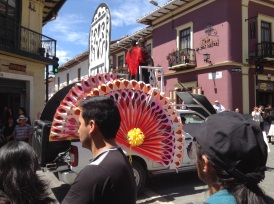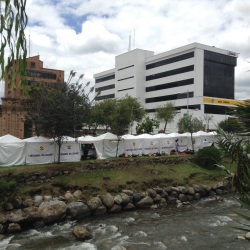Or “All Souls Day Meets Cuenca Independence Day”
While our US friends were “celebrating” Halloween and the end of Daylight Savings Time (except Arizona), Cuencanos were in the middle of a four day Fiesta (Oct. 31-Nov. 3). As a rule, Ecuadorians don’t need much incentive to organize a parade, shoot off fireworks, display arts and crafts, or amplify concerts from any number of city parks and plazas. So extending a two day holiday into four days so that you can have these expressions of celebration even longer makes sense!
El Dia de Difurtos is similar to Mexico’s Day of the Dead (or All Souls Day on Nov. 1) and is celebrated on Nov. 2. Families take picnics and food offerings and gather in the cemeteries where the graves of their dearly departed are located and have a family reunion of sorts. The next day, Nov. 3, the celebrations take a turn from the familial to the patriotic as the anniversary of Cuenca’s independence from Spain is celebrated. Friday and Saturday (Oct. 31 and Nov. 1) are just bonus days!
We heard that there were over 300 events scheduled during the four day weekend. In addition to the parades, fireworks, concerts, arts and crafts, there were numerous races, exhibitions, sporting events, competitions and activities for children. Traditional food and artisan’s booths were in abundance as were traffic and crowds. We took in only a few activities on Saturday and Monday.
We met up with our friends Kathy and Lance in El Centro and enjoyed watching the School Children Parade (our name for it!) As far as we could tell, most, if not all schools in Cuenca had students representing their various institutions with bands, dancers and drum corps. Parades put people in a good mood, we think, because even though the streets were crowded with onlookers, everybody was very considerate and made room for spectators and photographers to get a good view. Here are some pictures from this parade.






Two traditional foods that are only served during this time of the year are Guagua de Pan and Colada Morada. We enjoyed both on this day. Guagua is the Quechua word for baby and is pronounced “wa-wa”. The sweet bread is formed into the shape of an armless and legless baby and decorated with icing. Colada Morada is a thick, purplish, warm drink made of various fruits (naranjilla, babaco, pineapple, blackberries, strawberries and blueberries) sweetened with cane sugar (panela) and thickened with black corn flour. Guagua de Pan and Colada Morada are both offered and consumed at the cemeteries during All Saints Day.




On Monday, the 194th anniversary of Cuenca’s Independence from Spain, we had two parades to choose from. We opted for the “Morlaquia” parade over the very popular military parade. We heard the military parade was HUGE and wondered what would have happened if there had been a military emergency at the same time. Reports have it that there could have been every single tank, jeep, soldier, gun, and all other type of military apparatus of all the Ecuadorian branches of the military in this parade! There were also several fly-overs by air force fighter jets all during the weekend. We didn’t even know there was an Ecuadorian Air Force!
Anyway, back to what we experienced. The Morlaquia parade featured the people (mostly women) from the neighborhoods and surrounding villages of Cuenca. At the conclusion of the parade, there was the Cholita Cuencana contest. Our research into Chola Cuencana resulted in a very vague, and hopefully not too inaccurate understanding of this custom. Chola Cuencana is an archetypical woman of mixed Spanish and indigenous heritage who embodies all the positive attributes of both cultures. The parade that we attended featured women and girls of all ages from all over the Azuay province. Participants were walking, dancing, or riding on “floats” and exhibiting each neighborhoods’ traditional clothing, dances, crops, livestock, handmade goods and other economical contributions of the women of these regions. It appeared that each regional group had a young woman, often accompanied by her father, who was an entrant in the “Cholita Cuencana” pageant.
Further research into the Chola identity reveals that there is quite a little struggle between the older more traditional women who desire their offspring to continue to exhibit the Chola traditional clothing, economics and behavior and the younger, more modern women who are resisting this somewhat archaic model. Sounds a lot like the US in the 60’s and 70’s and the Women’s Lib movement. At any rate, for festival days and the accompanying parades, it would seem like the Chola is alive and well. Here are a few images from the Morlaquia parade.
Exhibits and contests of various artistic genres was prevalent. Mile after mile (it would seem) of white tents lined major avenues of the city, filled with the products of thousands of artisans not only from Cuenca and Ecuador, but the neighboring countries of Peru, Chile, and Colombia as well. We did not purchase any of the amazing variety of crafts but enjoyed looking while trying to stay protected from the intense equatorial midday sun!





Hopefully, this post gives you a tiny taste of what a festival weekend in Cuenca is like. As we said, we participated in a very small fraction of what was going on. In the very near future, we have the celebrations of Christmas, New Year, Mardi Gras and more. We have to pace ourselves!
Next post will be about some of our everyday experiences and we hope to give you an idea of some similarities and differences of living in Ecuador compared to the US. You might be surprised in what you read! Stay tuned.
Here’s what we’ve learned: We should NEVER go to Coral department store on a Sunday afternoon. It’s like shopping on the day after Thanksgiving AND the first weekend after PFD distribution* combined.
Here’s what we need to learn: How to go about our routines and errands without being out in the midday sun or getting caught in a late afternoon thunderstorm.
*Alaskans know what I’m talking about. The rest of our readers: Google Alaska Permanent Fund Dividend.













I am pleased to see things like I remember in Guayaquil in 1964…parades were very popular then. I marched with the entire Colegio Americano in our wool uniforms. Fortunately, we only wore them for parades. We sang the Ecuadorian anthem “Salve O Patria” (I still remember part of the first line)
LikeLike
Thanks, Laurie. I’m going to have to learn “Salve O Patria”! Even though we are entering into summer here in Cuenca, many people are still wearing scarves and sweaters. But in Guayaquil that would be even more miserable.
LikeLike
I love reading about your adventures and eagerly look forward to each new post:-)
LikeLike
Thank you Lisa. We’re so glad you read our blog and like it!
LikeLike
Great photos. Wonderful descriptions. Enjoyed it all, Gary G
LikeLike
Thanks Gary! We appreciate your kind words.
LikeLike
Keep it up. We are learning, always learning!
LikeLike
Thanks, Holly. Will you be here by Mardi Gras?
LikeLike
Wow, such a colorful celebration! I like your format of “what we’ve learned–what we need to learn”. So glad you’re having this marvelous experience. I’m envious…
LikeLike
Thanks so much, Mary. We are learning so much everyday. We would love to have you and Doug visit us. Considerate it . . .
LikeLike